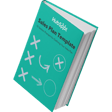Imagine if a salesperson could combine the most successful elements of every email they’ve sent to create a super-email.
With A/B testing, that’s actually possible. An A/B email test compares two versions of the same message to see which performs better.
Senders can test anything from subject line to email signature to their call-to-action. Once the results are in, reps can continue using the more successful version and scrap the old one. Continual A/B testing essentially allows salespeople to get closer and closer to the “perfect” sales email.
Let’s dive into the logistics of A/B testing and 12 elements salespeople should try testing.
How to A/B Test Sales Emails
Salespeople should follow three guidelines when A/B testing emails.
1) Test one variable at a time.
While it can be tempting to experiment with several things at once, they should stick to one change at a time. If two nearly identical emails perform differently, reps can identify the specific variable making one of the messages more effective.
2) Aim for statistical significance.
Salespeople should avoid jumping to conclusions. It’s easy to get skewed results with a small sample size, so salespeople should aim for 100 emails per test: 50 with one version, 50 with another.
3) Choose a goal for every test.
That goal will determine how reps measure success. There are three main metrics salespeople can track:
- Open rate: The percentage of people opening an email shows how engaging their subject line and first line are.
- Reply rate: This statistic is crucial to reps. Whether a prospect replies to an email can be impacted by a vast number of factors, including the email’s content, tone, length, style, accuracy, level of customization, send time, and more.
- Clickthrough rate: Looking at how many recipients have clicked in-message links or opened attachments tells salespeople how relevant their content is.
Which Elements of Your Emails to A/B Test
Almost every element of an email is testable.
Subject Line:
The subject line’s importance belies its length: 33% of people decide whether to open a message based on the subject line alone.
Salespeople can drive major results by figuring out how to customize this part of the email.
- Format: It’s beneficial to know whether statements or questions have a bigger impact. For example, a rep could compare “5 tips for Facebook marketing campaigns” with “Interested in Facebook marketing campaign tips?”
- Length: A good subject line is concise, but that doesn’t mean a eight-word title can’t outperform a three-word one.
- Specificity: Some prospects are intrigued by a little mystery, while other audiences might prefer clarity. Salespeople should test whether a line like, “Hoping to help” outperforms “Hoping to help with [business challenge]”.
Email:
- Salutation: Reps can experiment with different greetings (like “Hello,” “Hey,” “Hi,” or “Hey there,”) to see which one their prospects are most responsive to.
- Tone: Depending on the salesperson’s industry and their typical prospect’s status, a more formal tone might be necessary. Or maybe a relaxed, casual tone works like a charm. Salespeople won’t know until they experiment.
- The call-to-action: Instead of ending by asking for a call, HubSpot VP of Sales Pete Caputa recommends closing with a thought-provoking question or asking about their organization.
Alternatively, reps can experiment with different ways of requesting a call. They might compare how many prospects respond when they propose a single time versus two. A salesperson using a meeting scheduling app can test the efficacy of letting the buyer book time on her calendar versus suggesting a date and time herself. - Resources: Some white papers, case studies, blog posts, and/or testimonials will resonate with prospects more than others. With HubSpot Sales, reps can see when recipients clicked on a link or opened a document. They’ll even be notified if a buyer forwards a piece of content to their colleague.
- Quantity of content: More isn’t always better. Prospects may feel overwhelmed by an email full of links and attachments, even if each piece is relevant and helpful. Salespeople should find the optimal number to include by testing their engagement rates.
- Level of personalization: Personalized emails almost always perform better than generic ones. However, most reps can’t afford to spend 30 minutes on every outreach message. Split-testing the level of personalization -- for example, from two custom details to four -- will help salespeople identify how much personalization they should aim for.
- Postscript: Salespeople may find their prospects are pleasantly surprised by a custom postscript, such as, “P.S. Saw you’re also a Casablanca fan. I have to say, I think this could be the beginning of a beautiful partnership.” Looking at the response rates for emails with and without postscripts will reveal whether reps should include them.
- Length: Prospecting emails should typically be five sentences or fewer. But some reps, like HubSpot enterprise sales rep Dan Muscatello, swear by even more concise messages (two sentences!). Salespeople should experiment with short, shorter, and shortest emails to see what works with their target audience.
- Timing: Although every buyer has a slightly different schedule, salespeople may find a certain day of the week and/or time of day works better than others. Methodically testing send times helps reps identify when prospects are most likely to open their messages.
Once salespeople have figured out which elements of their messages perform best, they can start using these insights to write highly powerful emails. Even better? The more reps test, the better their emails become.





